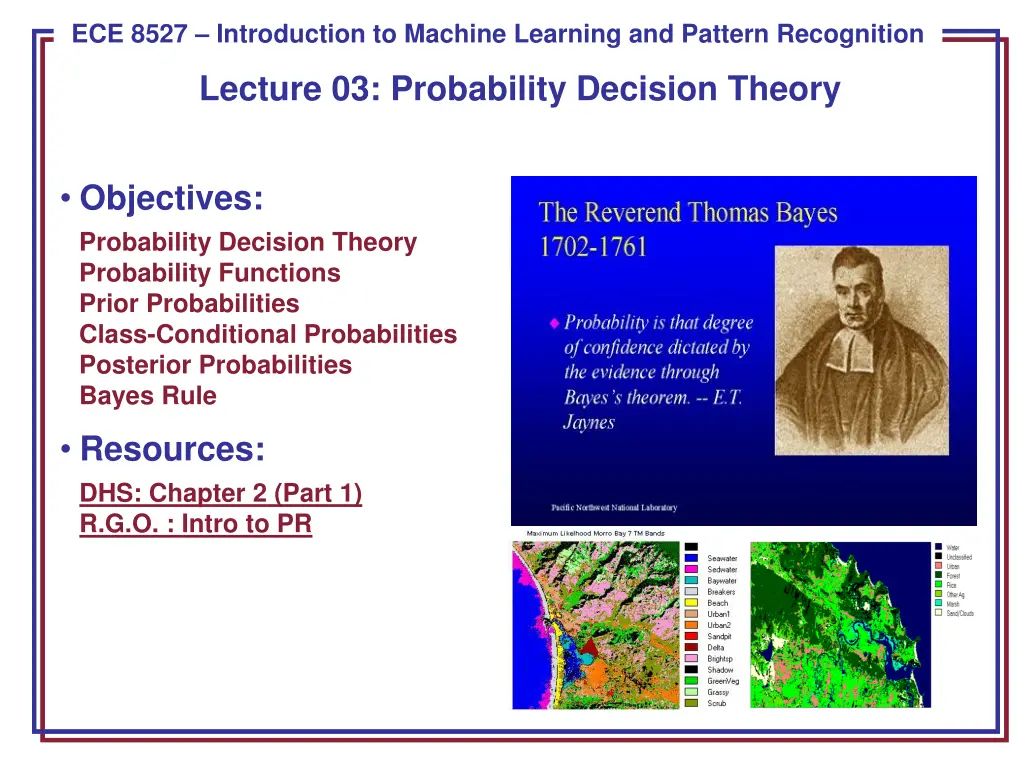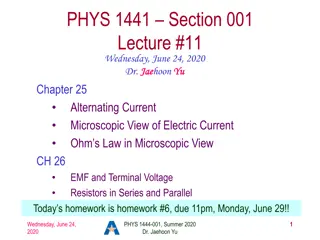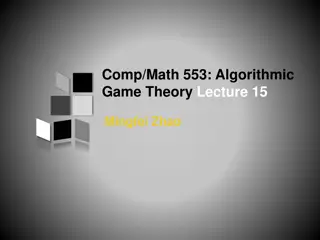
Probability Decision Theory in Pattern Recognition: Bayesian Approach
Explore the fundamentals of Bayesian Decision Theory in pattern classification, quantifying tradeoffs between classification decisions using probability distributions and costs. Learn how to leverage prior knowledge in classification problems such as fish species sorting through probability functions and decision rules.
Download Presentation

Please find below an Image/Link to download the presentation.
The content on the website is provided AS IS for your information and personal use only. It may not be sold, licensed, or shared on other websites without obtaining consent from the author. If you encounter any issues during the download, it is possible that the publisher has removed the file from their server.
You are allowed to download the files provided on this website for personal or commercial use, subject to the condition that they are used lawfully. All files are the property of their respective owners.
The content on the website is provided AS IS for your information and personal use only. It may not be sold, licensed, or shared on other websites without obtaining consent from the author.
E N D
Presentation Transcript
ECE 8443 Pattern Recognition ECE 8527 Introduction to Machine Learning and Pattern Recognition Lecture 03: Probability Decision Theory Objectives: Probability Decision Theory Probability Functions Prior Probabilities Class-Conditional Probabilities Posterior Probabilities Bayes Rule Resources: DHS: Chapter 2 (Part 1) R.G.O. : Intro to PR Z:\ece_8443\Fig1_48.jpg Z:\ece_8443\fig3.gif
Image Processing Example: Sorting Fish Sorting Fish: we seek to sort incoming fish according to their species using an optical sensing system (e.g., sea bass or salmon?) Problem Analysis: We will set up one or more cameras, collect some sample images to use for system development. How much data do we need to collect to develop a high performance system? We decide to extract features automatically from the images. With a little bit of thought, we decide to consider features such as length, lightness, width, number and shape of fins, position of mouth, etc. But how do we decide what is the best combination of features? Sensing Segmentation Feature Extraction ECE 8527: Lecture 03, Slide 1
Feature Combination: Width And Lightness Treat features as a N-tuple (two-dimensional vector) Create a scatter plot Draw a line (regression) separating the two classes ECE 8527: Lecture 03, Slide 2
Probability Decision Theory Bayesian Decision Theory is a fundamental statistical approach to the problem of pattern classification. It allows us to quantify the tradeoffs between various classification decisions using probability and the costs that accompany these decisions. We assume all relevant probability distributions are known. Later, as part of the machine learning process, we will learn how to estimate these from data. Can we exploit prior knowledge using Bayesian Decision Theory? For example, in our fish classification problem: Are the sequence of fish predictable? (statistics) Is each class equally probable? (uniform priors) What is the cost of an error? (risk, optimization) ECE 8527: Lecture 03, Slide 3
Prior Probabilities State of nature is prior information Model the state of nature as a random variable, ?: ? = ??: the event that the next fish is a sea bass category 1: sea bass; category 2: salmon ? ?? = probability of category 1 ? ??= probability of category 2 ? ?? + ? ?? = 1 Exclusivity: ??and ??share no basic events Exhaustivity: the union of all outcomes is the sample space (either ?? or ??must occur) If all incorrect classifications have an equal cost: Choose ?? if ? ??>? ??; otherwise, choose ??. ECE 8527: Lecture 03, Slide 4
Class-Conditional Probabilities A decision rule with only prior information always produces the same result and ignores measurements. If ? ??>>? ??, we will be correct most of the time. Probability of error: ? ? = ??? ? ??,? ?? . Given a feature, ? (lightness), which is a continuous random variable, ?(?|??) is a class- conditional probability density function. ?(?|??) and ?(?|??) describe the difference in lightness between populations of sea and salmon. We often refer to these as likelihoods because they represent the likelihood of a value ? given that it came from class ??(or ??). ECE 8527: Lecture 03, Slide 5
Probability Functions A probability density function is denoted in lowercase and represents a function of a continuous variable. ??(?|?), often abbreviated as ?(?), denotes a probability density function for the random variable ?. Note that ??(?|?) and ??(?|?) can be two different functions. ?(?|?) denotes a probability mass function, and must obey the following constraints: ? ? ? ? ? = ? ? ? Probability mass functions are typically used for discrete random variables (which are summed) while densities describe continuous random variables (latter must be integrated). In this course, we mix both discrete variables (related to the number of classes) and continuous variables (the probability of a feature vector). ECE 8527: Lecture 03, Slide 6
Bayes Formula Suppose we know both ?(??) and ?(?|??), and we can measure ?. How does this influence our decision? The joint probability of finding a pattern that is in category ?? and that this pattern has a feature value of ? is: ? ??,? = ? ??? ? ? = ? ? ??? ?? Rearranging terms, we arrive at Bayes Rule, also known as Bayes Formula: ? ??? =? ? ??? ?? ? ? The denominator term, which is known as the evidence, combines the two numerator terms (for the case of two categories): ? ? ? = ? ? ??? ?? ?=? This is the probability that a particular value of x can occur. It is difficult to calculate because it is the sum across all possible conditions. ECE 8527: Lecture 03, Slide 7
Posterior Probabilities Bayes Rule: ? ??? =? ? ??? ?? ? ? can be expressed in words as: ????????? =?????????? ????? ???????? By measuring ?, we can convert the prior probability, ?(??), into a posterior probability, ?(??|?). Evidence can be viewed as a scale factor and is often ignored in optimization applications (e.g., speech recognition). Bayes Rule allows us to train a system by collecting data in what is called a supervised mode (e.g., collect a sea bass sample and measure its length, speak a specific set of words and measure the feature vectors). ECE 8527: Lecture 03, Slide 8
Posteriors Sum To 1.0 Two-class fish sorting problem (?(??) = ?/?,?(??) = ?/?): For every value of ?, the posteriors sum to ?. At ? = ??, the probability ? is in category ?? is ?.??. The probability ? is in ?? is 0.08. Likelihoods and posteriors are related via Bayes Rule. ECE 8527: Lecture 03, Slide 9
Evidence The evidence, ?(?), is a scale factor that assures conditional probabilities sum to 1: ? ??|? + ? ??|? = ? Using Bayes Rule: ? ????? = ??? ? ??? ,?(??|?) ? ??? =? ?|??? ?? and ? ??? =? ?|??? ?? ? ? ? ? ? ?|??? ?? ? ? ,? ?|??? ?? ? ? ? ????? = ??? We can eliminate the scale factor (which appears in both terms): ? ?? ??? ? ?|??? ??> ? ?|??? ?? Special cases: ? ?|?? = ? ?|??: ? gives us no useful information. ? ??= ? ??: priors give no useful information. ECE 8527: Lecture 03, Slide 10
Bayes Decision Rule Decision rule: For an observation ?, choose ?? if ?(??|?) > ?(??|?); otherwise, choose ??. Probability of error: ? ????? ? = ? ??? ? ?? ? ??? ? ?? The average probability of error is given by averaging ? ????? ? over ?: ? ????? = ? ?????,? ?? = ? ????? ? ? ? ?? ? ????? = ??? ? ??? ,?(|?) If for every ?we ensure that ? ????? ? is as small as possible, then the integral is as small as possible. Thus, Bayes decision rule minimizes ?(?????). ECE 8527: Lecture 03, Slide 11
Summary Probability Decision Theory: allows us to quantify the tradeoffs between various classification decisions using probability and the costs that accompany these decisions. Prior Probabilities: reflect our knowledge of the problem, which comes from subject matter expertise. Likelihoods: A model that assesses the probability a specific feature vector could have occurred from a specific class. Posterior Probabilities: the probability a class occurred given a specific feature vector (converts a measurement to a probability that it came from a specific class). Bayes Rule: factors a posterior into a combination of a likelihood, prior and the evidence. Is this the only appropriate engineering model? Bayes Decision Rule: choose the class that has the highest posterior. ECE 8527: Lecture 03, Slide 12






















